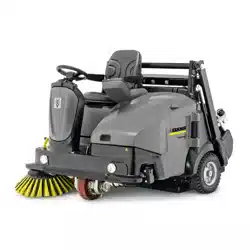Loading ...
Loading ...
Loading ...

-
12
Always disconnect the battery when
working on the electrics.
Turn the program selection switch to
"OFF".
Remove KIK-key.
ATTENTION
Using non-rechargeable batteries is prohib-
ited.
Only use batteries and chargers approved
by the manufacturer.
Replace batteries with the same battery
type only.
Prior to disposal of the vehicle, the batter-
ies must be removed and disposed of in ac-
cordance with local regulations.
ATTENTION
Follow accident prevention regulations as
well as DIN VDE 0510, VDE 0105 T.1.
Please observe the following warning notes
when handling batteries:
� DANGER
Risk of fire and explosion!
Do not place tools or similar items on
the battery. Risk of short-circuit and ex-
plosion.
Smoking and open flames must be
strictly avoided.
Rooms where batteries are charged
must have good ventilation because
highly explosive gas is emitted during
charging.
Danger of causticization!
Use caution with leaking batteries (sul-
phuric acid may leak).
Risk of injury!
Ensure that wounds never come into
contact with lead. Always clean your
hands after working on batteries.
When used normally, and when observing
the instructions, lead-acid batteries do not
pose any risk.
However, keep in mind that lead-acid bat-
teries contain sulphuric acid which can
cause chemical burns and corrosion.
If there is spillage or, if the battery is
leaking, acid is escaping, lay down a
binding agent such as sand. Do not let
it reach the sewer system, soil or a body
of water.
Neutralise the acid with lime/baking
soda and dispose of it according to local
regulations.
Contact a waste management compa-
ny to dispose of faulty batteries.
Rinse thoroughly with lots of clear water
if acid gets into the eye or comes in con-
tact with the skin.
Then consult a doctor immediately.
Wash off the acid If it comes in contact
with the clothes.
Change clothing.
Note: Upon delivery of the appliance the
battery terminal is disconnected, connect
the battery terminal prior to initial commis-
sioning.
Open the engine hood.
Unscrew and remove the angle bracket
of the battery.
Insert battery in battery mount.
Attach the battery by means of an angle
bracket.
Connect pole terminal (red cable) to
positive pole (+).
Connect pole terminal to negative pole
(-).
Attach the pole covers.
Note: Check that the battery pole and pole
terminals are adequately protected with
pole grease.
ATTENTION
Comply with safety regulations on the han-
dling of batteries. Observe the directions
provided by the manufacturer of the charg-
er.
ATTENTION
Charge the battery only with an appropriate
charger.
Open the engine hood.
Disconnect battery.
Connect positive terminal cable from
the charger to the positive pole connec-
tion on the battery.
Connect negative terminal cable from
the charger to the negative pole con-
nection on the battery.
Plug in mains connector and switch on
charger.
Note: When the battery is charged, first re-
move the charger from the mains and then
disconnect it from the battery.
Open the engine hood.
Disconnect pole terminal to negative
pole (-).
Disconnect pole terminal to positive
pole (+).
Remove the battery from the battery
holder.
Dispose of the used battery according
to the local provisions.
� CAUTION
Risk of damage!
Do not clean the appliance with a water
hose or high-pressure water jet (danger
of short circuits or other damage).
Do not use aggressive and abrasive de-
tergents.
�
DANGER
Health hazard!
Wear dust mask and protective gog-
gles.
Open the engine hood.
Blow through machine with com-
pressed air.
Clean the machine with a damp cloth
which has been soaked in mild deter-
gent.
Close engine bonnet.
Clean the machine with a damp cloth
which has been soaked in mild deter-
gent.
Observe the inspection checklist!
The service hour counter indicates the time
of the maintenance intervals.
Read the service hours: Push the direc-
tion keys "upwards" or "downwards".
Note: If the value reaches "0", a service
message with the phone number of the
local service branch is displayed when
the appliance is switched on.
Note: Where maintenance is carried out by
the customer, all service and maintenance
work must be undertaken by a qualified
specialist. If required, a specialised Kärch-
er dealer may be contacted at any time.
Note: For description, see section on Main-
tenance work.
Daily maintenance:
See chapter "Prior to start/safety test".
Weekly maintenance:
Check leakiness of fuel or gas connec-
tions.
Check dust filter and clean filter box, if
required.
Check air filter.
Check oil level of sweeper hydraulics.
Check hydraulic lines for leaks.
Battery
Safety notes regarding the batteries
Observe the directions on the
battery, in the instructions for
use and in the vehicle operat-
ing instructions!
Wear an eye shield!
Keep away children from acid
and batteries!
Risk of explosion!
Fire, sparks, open light, and
smoking not allowed!
Danger of causticization!
First aid!
Warning note!
Disposal!
Do not throw the battery in the
dustbin!
Procedures in the event of unintentional
release of battery acid
Installing and connecting the battery
Charging battery
Remove the battery
Cleaning
Cleaning the inside of the machine
External cleaning of the appliance
Maintenance intervals
Maintenance by the customer
39EN
Loading ...
Loading ...
Loading ...
